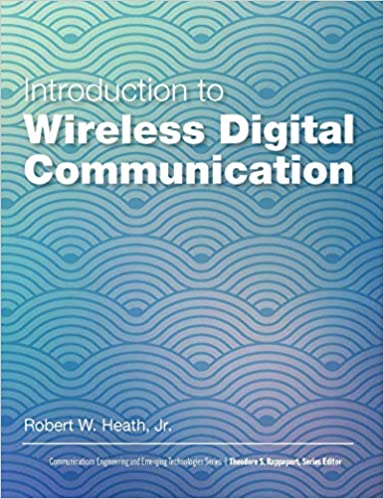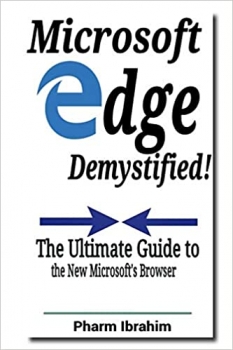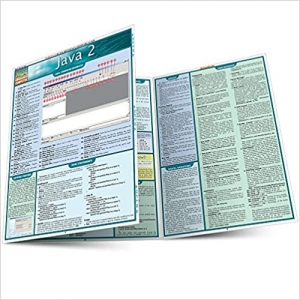Product details
- ASIN : B06Y1BQ8QV
- Publisher : Pearson; 1st edition (April 4, 2017)
- Publication date : April 4, 2017
- Language : English
- File size : 20390 KB
- Simultaneous device usage : Up to 5 simultaneous devices, per publisher limits
- Text-to-Speech : Enabled
- Screen Reader : Supported
- Enhanced typesetting : Enabled
- X-Ray : Not Enabled
- Word Wise : Not Enabled
- Print length : 836 pages
- Lending : Not Enabled
کتاب Introduction to Wireless Digital Communication: A Signal Processing Perspective
The Accessible Guide to Modern Wireless Communication for Undergraduates, Graduates, and Practicing Electrical Engineers
Wireless communication is a critical discipline of electrical engineering and computer science, yet the concepts have remained elusive for students who are not specialists in the area. This text makes digital communication and receiver algorithms for wireless communication broadly accessible to undergraduates, graduates, and practicing electrical engineers. Notably, the book builds on a signal processing foundation and does not require prior courses on analog or digital communication.
Introduction to Wireless Digital Communication establishes the principles of communication, from a digital signal processing perspective, including key mathematical background, transmitter and receiver signal processing algorithms, channel models, and generalizations to multiple antennas. Robert Heath’s “less is more” approach focuses on typical solutions to common problems in wireless engineering.
Heath presents digital communication fundamentals from a signal processing perspective, focusing on the complex pulse amplitude modulation approach used in most commercial wireless systems. He describes specific receiver algorithms for implementing wireless communication links, including synchronization, carrier frequency offset estimation, channel estimation, and equalization. While most concepts are presented for systems with single transmit and receive antennas, Heath concludes by extending those concepts to contemporary MIMO systems.
To promote learning, each chapter includes previews, bullet-point summaries, examples, and numerous homework problems to help readers test their knowledge.
- Basics of wireless communication: applications, history, and the central role of signal processing
- Digital communication essentials: components, channels, distortion, coding/decoding, encryption, and modulation/demodulation
- Signal processing: linear time invariant systems, probability/random processes, Fourier transforms, derivation of complex baseband signal representation and equivalent channels, and multi-rate signal processing
- Least-squared estimation techniques that build on the linear algebra typically taught to electrical engineering undergraduates
- Complex pulse amplitude modulation: symbol mapping, constellations, signal bandwidth, and noise
- Synchronization, including symbol, frame, and carrier frequency offset
- Frequency selective channel estimation and equalization
- MIMO techniques using multiple transmit and/or receive antennas, including SIMO, MISO, and MIMO-OFDM
Register your product at informit.com/register for convenient access to downloads, updates, and corrections as they become available.
منابع کتاب کتاب Introduction to Wireless Digital Communication: A Signal Processing Perspective
راهنمای قابل دسترس برای ارتباطات بی سیم مدرن برای دانشجویان کارشناسی، فارغ التحصیلان و مهندسان برق
ارتباطات بی سیم یکی از رشته های مهم مهندسی برق و علوم کامپیوتر است، با این حال این مفاهیم برای دانشجویانی که در این زمینه متخصص نیستند، مبهم باقی مانده است. این متن ارتباط دیجیتال و الگوریتم های گیرنده برای ارتباطات بی سیم را به طور گسترده برای دانشجویان، فارغ التحصیلان و مهندسان برق در دسترس قرار می دهد. قابل ذکر است، این کتاب بر اساس پردازش سیگنال ساخته شده است و نیازی به دوره های قبلی در مورد ارتباطات آنالوگ یا دیجیتال ندارد.
مقدمهای بر ارتباطات دیجیتال بیسیم ، اصول ارتباط را از منظر پردازش سیگنال دیجیتال، از جمله پسزمینه کلیدی ریاضی، الگوریتمهای پردازش سیگنال فرستنده و گیرنده، مدلهای کانال و تعمیم به چندین آنتن، ایجاد میکند. رویکرد "کمتر، بیشتر" رابرت هیث بر راه حل های معمولی برای مشکلات رایج در مهندسی بی سیم تمرکز دارد.
هیث اصول ارتباطات دیجیتال را از منظر پردازش سیگنال ارائه میکند، با تمرکز بر رویکرد مدولاسیون دامنه پالس پیچیده که در اکثر سیستمهای بیسیم تجاری استفاده میشود. او الگوریتمهای گیرنده خاصی را برای پیادهسازی لینکهای ارتباطی بیسیم، از جمله همگامسازی، تخمین افست فرکانس حامل، تخمین کانال و یکسان سازی توصیف میکند. در حالی که بیشتر مفاهیم برای سیستمهایی با آنتنهای فرستنده و گیرنده منفرد ارائه میشوند، هیث با گسترش آن مفاهیم به سیستمهای MIMO معاصر نتیجهگیری میکند.
برای ترویج یادگیری، هر فصل شامل پیشنمایشها، خلاصههای نقطهای، مثالها و مشکلات متعدد تکلیف میشود تا به خوانندگان کمک کند دانش خود را آزمایش کنند.
- مبانی ارتباطات بی سیم: برنامه های کاربردی، تاریخچه و نقش مرکزی پردازش سیگنال
- ملزومات ارتباط دیجیتال: اجزاء، کانال ها، اعوجاج، کدگذاری/رمزگشایی، رمزگذاری، و مدولاسیون/دمولاسیون
- پردازش سیگنال: سیستمهای ثابت زمان خطی، فرآیندهای احتمال/تصادفی، تبدیل فوریه، مشتق از نمایش سیگنال باند پایه پیچیده و کانالهای معادل، و پردازش سیگنال چند نرخی
- روشهای برآورد حداقل مربعات که بر اساس جبر خطی است که معمولاً به دانشجویان مهندسی برق آموزش داده میشود.
- مدولاسیون دامنه پالس پیچیده: نگاشت نماد، صور فلکی، پهنای باند سیگنال و نویز
- همگام سازی، از جمله نماد، فریم، و فرکانس حامل
- تخمین و یکسان سازی کانال انتخابی فرکانس
- تکنیکهای MIMO با استفاده از آنتنهای ارسال و/یا دریافت چندگانه، از جمله SIMO، MISO، و MIMO-OFDM
محصول خود را در informit.com/register برای دسترسی راحت به دانلودها، به روز رسانی ها و اصلاحات به محض در دسترس بودن ثبت کنید































ارسال نظر درباره کتاب Introduction to Wireless Digital Communication: A Signal Processing Perspective